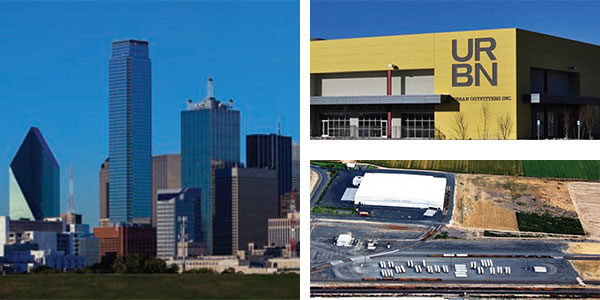Emerging logistics hot spots: The West

When one thinks of an ideal West Coast venue for a "logistics cluster," Quincy, Wash., doesn't spring to mind.
Rather, the default location is the area of Southern California stretching from the ports of Los Angeles and Long Beach eastward to the warehouse-rich "Inland Empire." The corridor offers superior infrastructure, a critical mass of third-party logistics service providers (3PLs), and a large pool of potential employees, the ingredients for an ideal "logistics cluster," a term popularized by Massachusetts Institute of Technology Professor Yossi Sheffi in his book Logistics Clusters: Delivering Value and Driving Growth.
"If you are importing and 50 percent or more of your product is coming into the Port of Long Beach or Los Angeles, you need to be close to the port, even though real estate costs will be high and so will labor costs," says Tom Patterson, senior vice president, West Coast operations, for Saddle Creek Logistics Services, a Lakeland, Fla.-based 3PL.
But many of Saddle Creek's clients have found that because of its huge geography, the West cannot be efficiently served from Southern California alone, says Patterson. In addition, high property prices and traffic congestion have sent businesses searching for more cost-effective locations. Three of those are Dallas/Fort Worth; Reno, Nev.; and, yes, the central Washington hamlet of Quincy, Wash.—population, as of 2010: 6,750.
DALLAS/FORT WORTH
The Dallas/Fort Worth area has been "on a little bit of a rush" lately when it comes to the building of distribution centers, according to Mike Rosa, senior vice president of economic development for the Dallas Regional Chamber.
Rosa rattles off just a few of the deals that have been inked in the past 18 months: a 951,000-square-foot e-fulfillment center for retailer Kohl's, a 300,000-square-foot parts distribution center for BMW, and a 513,000-square-foot regional warehouse for L'Oreal Group.
Much of the increased industrial activity is driven by the law of large numbers. The Dallas-Fort Worth Metroplex is the fourth most populous metro area in the country with 7 million people.
But the region has more going for it than just population. "Our strength really comes when we layer on top of that our transportation connectivity," says Rosa.
The highway system around the area provides transportation corridors stretching both north and south (Interstate 35W, which runs from Mexico to Canada) and east and west (including Interstate 20 and Interstate 30). The Dallas-Fort Worth area is a hub of rail activity, with the Burlington Northern Santa Fe (BNSF) lines from the Port of Long Beach and the Union Pacific Corp. line from Houston converging there. The area also has a strong air-cargo capability. In addition to the Dallas/Fort Worth International Airport, which saw 329,000 tons of cargo move through it in 2012, the area is home to the world's first dedicated industrial airport, Fort Worth Alliance Airport.
Dallas also benefits from a pro-business environment with a favorable tax culture, a large employee pool, and a temperate climate.
"But all that doesn't matter if you don't have a building or someone who can build a building," says Rosa. According to Rosa, one way that Dallas sets itself apart from competing regions is the level of sophistication that exists in its real estate development community. Developers in the area are well versed in what it takes to construct sophisticated logistics industrial parks like the 9,600-acre Alliance Global Logistics Hub, an inland port connected to the Alliance airport. "We look ahead at developing industrial areas and industrial parks that meet the needs of shippers now and in the future," Rosa says.
RENO, NEV.
A tongue-in-cheek slogan for the Reno, Nev., area might be "Western Nevada: We're not California." Indeed, a company can get its goods from a distribution center in Reno to anywhere in California within a one-day drive—all the while avoiding the high taxes and heavy regulation that California is infamous for.
"We compete extremely well against California because of our tax base here," says Stan Thomas, executive vice president of marketing and competitive expansion for the Economic Development Authority of Western Nevada. "There's no corporate tax or state income tax. Our utilities are less than California's, and our unemployment insurance is less. Also, our property taxes are a little bit lower."
Reno can also serve 10 other western states with a one-day drive, says Thomas—even the hard-to-reach Pacific Northwest. The area is a hub for UPS Inc. and FedEx Corp. as well as regional parcel carrier OnTrac. It is also served by all major trucking companies as well as the BNSF and Union Pacific.
The ease of reaching major western markets has made the area particularly attractive to businesses engaged in e-commerce distribution, as well as to retail, pharmaceutical, and nutraceutical companies. Currently, there are 74 million square feet of warehousing and distribution space in the Western Nevada area, which includes Reno, Sparks, and Tahoe, according to Thomas. Companies with large distribution centers in the area include traditional brick-and-mortar retailers like JC Penney and Toys R Us as well as e-commerce merchants like Amazon.com and Diapers.com. The trendy retailer Urban Outfitters has its imports brought from the Port of Los Angeles or Long Beach to its distribution center in Reno and shipped from there, rather than locating a facility near the ports.
While Reno's position on the logistics map may be what attracts companies, it's the ease of doing business that keeps them there, sometimes expanding to include manufacturing or even their corporate headquarters, according to Thomas. He notes the speed in which companies can obtain state and city licenses (within one day) and building permits (within three to four weeks). The DC itself can get built in six months, he says.
QUINCY, WASH.
If you're looking for a green spot for your warehouse or distribution center, you might want to consider Quincy, Wash.
Quincy offers access to hydropower from dams along the Columbia and Snake rivers. The energy source is both environmentally friendly—hydropower is carbon neutral—and inexpensive. "Grant County [where Quincy is located] has some of the cheapest hydropower rates in the country," says Patrick Boss, vice president of public affairs and business development for the Port of Quincy.
According to an analysis by the site selection firm Boyd Co. Inc., electricity in Quincy is priced at 2 cents per kilowatt, compared with 15 cents per kilowatt in Chicago. Because of the hydropower dams, there is also significant electrical infrastructure in Grant County. "For a little town of 7,000 people, that means there's more power per capita than probably any other place in the world," Boss says.
The low cost and plentiful supply of energy is an attractive feature for companies requiring cold storage facilities, such as those associated with the state's ubiquitous agriculture industry. According to Boss, many crops that need refrigeration are located within a 70- to 80-mile radius of Quincy. "If a massive 1 million-square-foot cold storage distribution center wanted to locate here and it needed 10 megawatts of energy, that would be nothing," Boss says.
Another sign of Quincy's potential for green distribution is its growing importance as a rail intermodal hub for central Washington. Quincy is 10 miles north of Interstate 90, which runs from Seattle to Boston. It is also located on a BNSF main line that serves the city six days a week. When the Port of Quincy Intermodal Terminal was built, the intent was for the goods to be shipped by rail to the Port of Seattle for export to Asia. While the initiative never panned out, the port did find a market for long-haul eastbound shipments. Today, BNSF's "Cold Train Express Refrigerated Intermodal Service" brings shipments of mostly fresh foods and perishables from Quincy to 19 states and one Canadian province. The expedited service reaches Chicago in four days and Boston in six to seven, says Boss. On the backhaul, the service carries dry goods to be distributed across the Northwest.
All of this green can save a company a lot of green, according to consultancy Boyd Co., which studied the costs of operating a 500,000-square-foot DC in various western locations. The study found it would cost $14.1 million to operate the facility in Quincy, compared with $20.7 million in Los Angeles.
Want to learn more about the logistics clusters mentioned in this article? Here's where to find more information:
Dallas
- Dallas Regional Chamber: This economic development organization's website provides facts about the Dallas-Fort Worth area and locating there, including information on the region's transportation infrastructure.
- AllianceTexas: Information about the Alliance Global Logistics Hub, a key inland port in the region, includes a drayage calculator.
Reno, Nev.
- EDAWN or the Economic Development Authority of Western Nevada: This private/public partnership is committed to recruiting companies to the Greater Reno-Sparks-Tahoe area. Its website contains helpful information about the region's workforce and taxes/incentives as well as a building and sites database and case studies of companies that have found success there.
Quincy, Wash.
- Port of Quincy: The inland port's website contains information on locating a business in Quincy, Wash.; the intermodal terminal; and the port's cold train service.
Related Articles

Copyright ©2024. All Rights ReservedDesign, CMS, Hosting & Web Development :: ePublishing